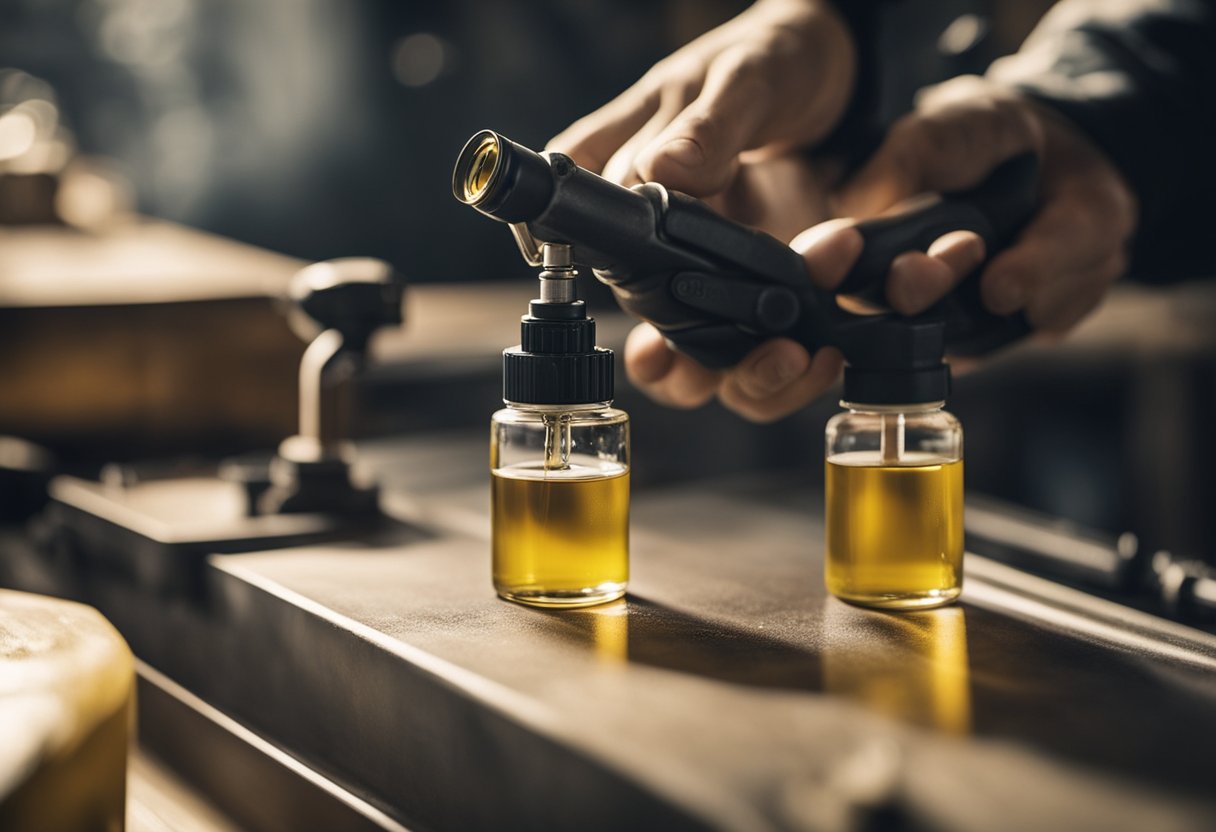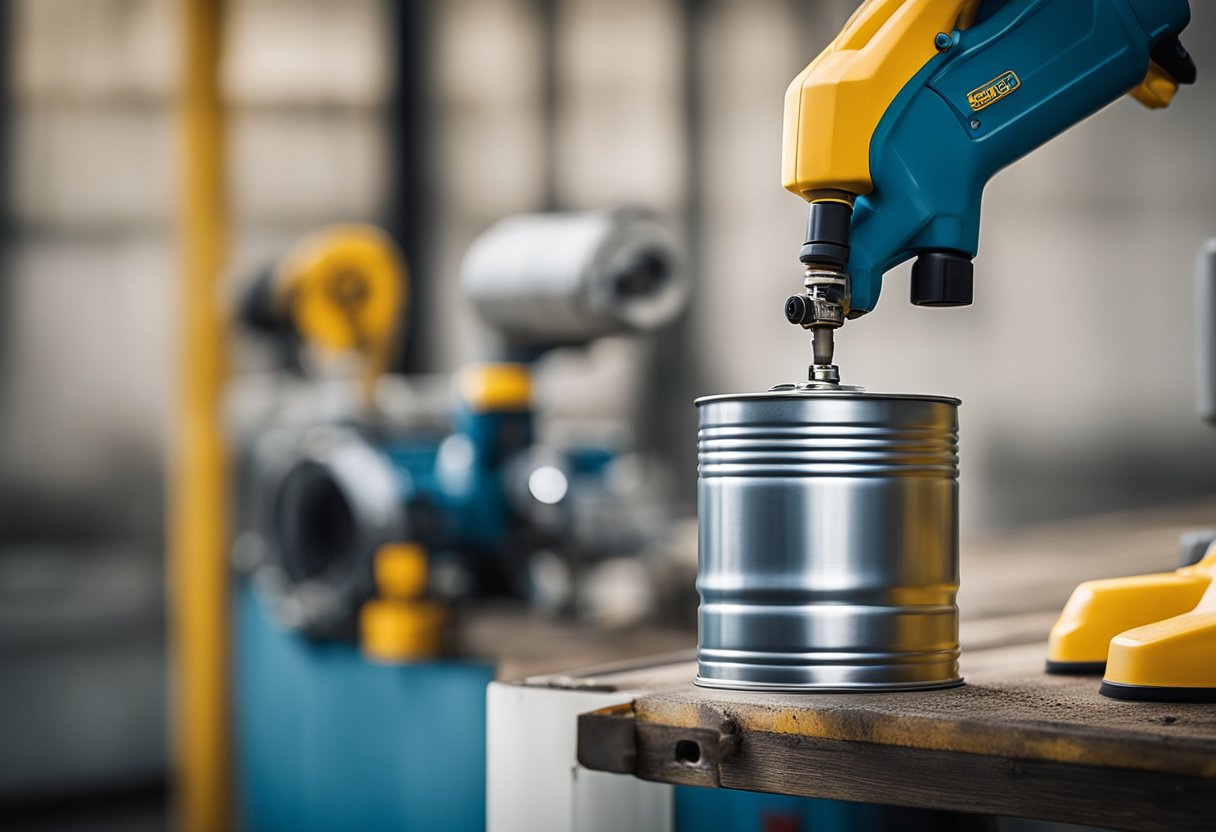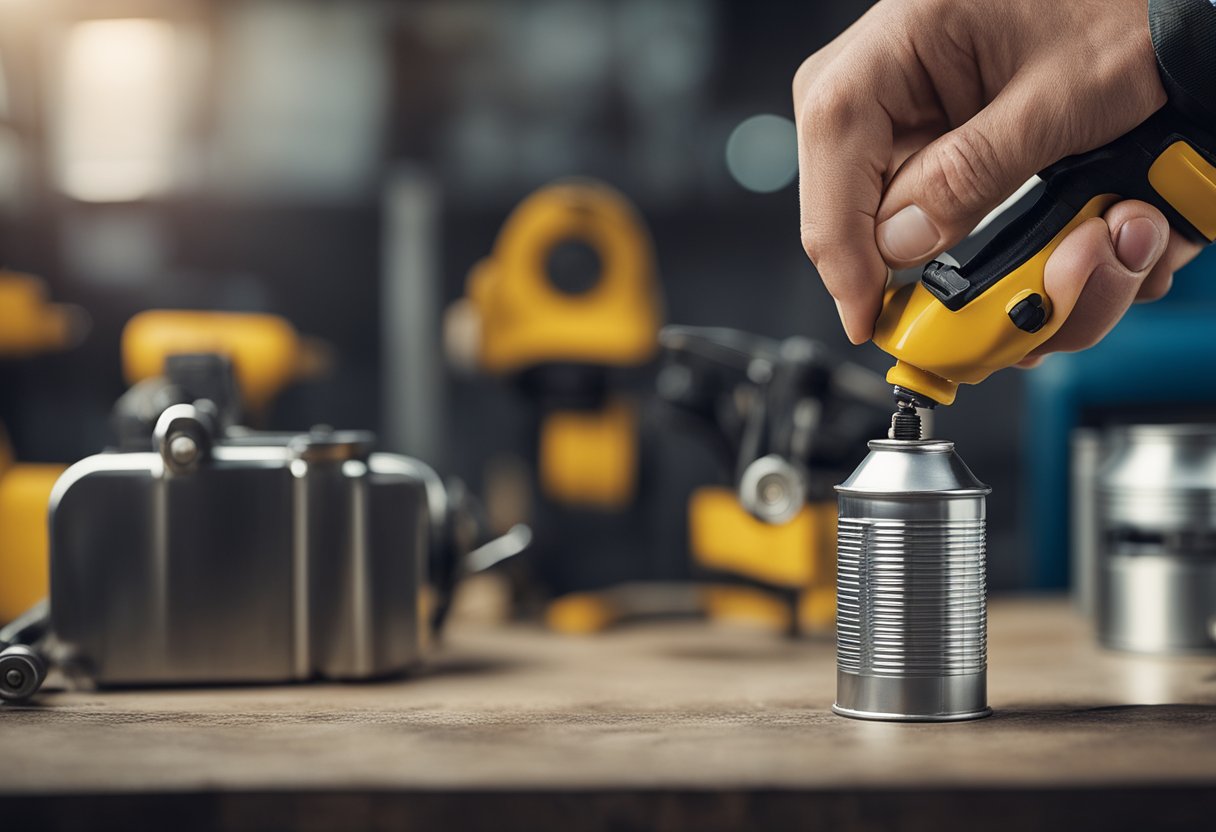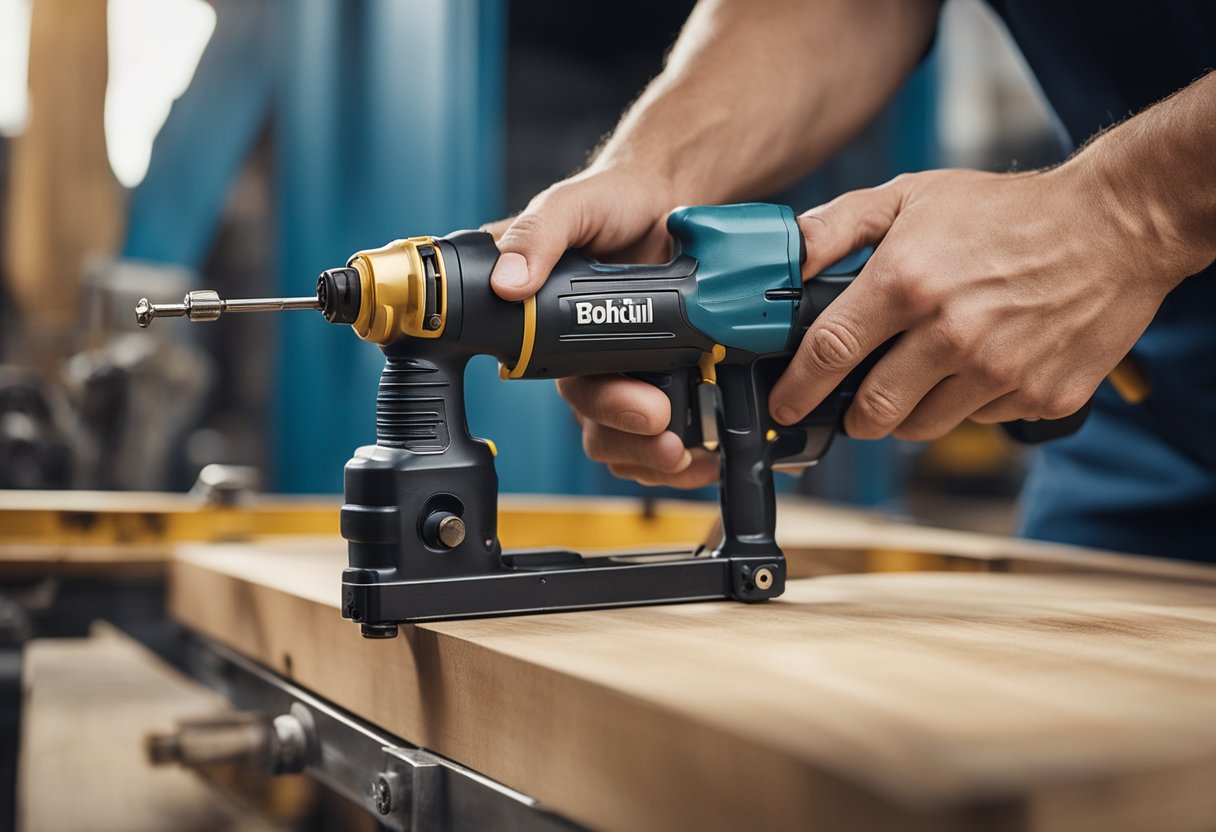As a DIY enthusiast or professional carpenter, you know that a nail gun is an essential tool for fast and efficient work. However, like any other tool, a nail gun requires proper maintenance to function optimally. One of the most critical aspects of nail gun maintenance is oiling. In this article, I will guide you through the process of oiling a nail gun to extend its lifespan and ensure that it works correctly every time you need it.
Before we dive into the oiling process, let’s first understand the importance of oiling a nail gun. Oiling your nail gun regularly helps to lubricate the moving parts, reducing friction and wear. This, in turn, prevents the nail gun from overheating and prolongs its lifespan. Furthermore, oiling your nail gun helps to prevent rust and corrosion, which can cause damage to the tool and reduce its performance. With that said, let’s get started with the oiling process.
Key Takeaways
- Understanding the importance of oiling your nail gun can help you extend its lifespan and ensure optimal performance.
- Choosing the right oil is crucial to ensure that your nail gun functions correctly.
- Following a step-by-step guide to oiling your nail gun can help you do it safely and effectively.
Understanding Your Nail Gun
https://www.youtube.com/watch?v=EKANcOPnL5o&embed=true
As a power tool, a nail gun is an essential tool for carpentry and construction projects. Understanding how it works is crucial to maintaining it properly.
There are several types of nail guns, including pneumatic, cordless, and electric. Pneumatic nail guns use compressed air to drive nails into the workpiece, while cordless and electric nail guns use batteries or electricity, respectively. Each type has its own unique maintenance requirements, so it’s important to consult your user manual for specific instructions.
Regardless of the type of nail gun, they all have similar components, including the magazine, trigger, and piston. The magazine is where the nails are loaded, and the trigger controls when the nail is fired. The piston is what drives the nail into the workpiece.
It’s important to keep these components clean and well-lubricated to ensure smooth operation. Failure to do so can result in misfires and damage to the nail gun. Consult your user manual for specific instructions on how to disassemble and lubricate your nail gun.
In summary, understanding the components of your nail gun and how they work is crucial to proper maintenance. Regular cleaning and lubrication will ensure smooth operation and extend the life of your nail gun. Consult your user manual for specific instructions on how to maintain your particular type of nail gun.
Importance of Oiling a Nail Gun
https://www.youtube.com/watch?v=ZwwQ1XbcTqc&embed=true
As someone who has worked with nail guns for years, I cannot stress enough the importance of regular oiling for optimal performance and longevity. Proper maintenance of your nail gun with oil can prevent jamming, extend its lifespan, and ensure that it always performs at its best.
When using a nail gun, it’s crucial to keep it well-maintained to reduce friction and wear and tear on the moving parts. Without proper lubrication, the friction between the parts can cause damage to the nail gun, leading to costly repairs or even the need for a replacement. By investing a small amount of time and money into regular maintenance, you can save yourself a significant amount of money in the long run.
Regular oiling also improves the efficiency and accuracy of the nail gun. When the parts are well-lubricated, the gun works smoothly and accurately, reducing the risk of errors and mistakes. This is especially important for professionals who rely on their nail guns for their work.
In addition to improving performance, regular oiling also reduces the risk of jamming. A nail gun that is not properly lubricated is more likely to jam, causing frustration and delays in your work. By keeping your nail gun well-oiled, you can reduce the risk of jamming and ensure that your work is completed efficiently and on time.
In summary, regular oiling of your nail gun is an essential part of its maintenance. It reduces friction, extends the lifespan, improves efficiency and accuracy, and reduces the risk of jamming. By investing a small amount of time and money into regular maintenance, you can ensure that your nail gun always performs at its best.
Choosing the Right Oil
When it comes to choosing the right oil for your nail gun, there are a few factors to consider. First and foremost, it’s important to use a lubricant that is specifically designed for nail guns. Using the wrong type of oil can cause damage to your tool and may even void your warranty.
There are several types of oil that can be used for nail guns, including motor oil, synthetic oil, mineral oil, transmission fluid, and non-detergent oil. However, it’s important to note that not all oils are created equal, and some may not be suitable for use with your nail gun.
For this reason, it’s always best to use the manufacturer’s recommended oil. This information can usually be found in the owner’s manual or on the manufacturer’s website. Using the recommended oil will ensure that your nail gun operates smoothly and efficiently, and will help to extend its lifespan.
In addition to the manufacturer’s recommended oil, there are also specialty oils that are specifically designed for use with pneumatic tools. These oils, such as compressor oil and hydraulic oil, are formulated to withstand the high pressures and temperatures that are generated by pneumatic tools.
It’s also important to note that synthetic oils are becoming increasingly popular for use with nail guns. These oils offer superior lubrication and can help to reduce wear and tear on your tool. However, it’s important to check with the manufacturer to ensure that synthetic oils are suitable for use with your specific nail gun.
In summary, choosing the right oil for your nail gun is essential for proper maintenance and optimal performance. Always use the manufacturer’s recommended oil or a specialty oil designed for pneumatic tools, and consider using synthetic oils for superior lubrication.
Step-by-Step Guide to Oiling
https://www.youtube.com/watch?v=wRuct3iuS_M&embed=true
When it comes to maintaining your nail gun, oiling is an essential part of the process. Proper oiling helps to keep your nail gun in good working condition and prevents it from getting damaged. Here are the steps to follow when oiling your nail gun:
-
Turn off your nail gun: Before you start oiling your nail gun, make sure to turn it off. If you are using a pneumatic nail gun, turn off the air tool and release pressure from the pressure valve.
-
Wipe off any excess oil: Before applying new oil, wipe off any excess oil from your nail gun. This helps to prevent the oil from dripping onto your workpiece and causing damage.
-
Apply a few drops of oil: Apply a few drops of oil to the nail gun’s air inlet. Be careful not to over-oil your nail gun, as this can cause damage. A general rule of thumb is to apply 2-3 drops of oil per day of use.
-
Run the nail gun: After applying oil, run the nail gun for a few seconds to allow the oil to circulate throughout the tool. This helps to ensure that all the moving parts are lubricated properly.
-
Wipe off any excess oil: After running the nail gun, wipe off any excess oil from the tool. This helps to prevent the oil from dripping onto your workpiece and causing damage.
-
Repeat as necessary: Depending on how often you use your nail gun, you may need to oil it daily or weekly. It’s important to follow the manufacturer’s recommendations for how often to oil your nail gun.
By following these simple steps, you can ensure that your nail gun remains in good working condition and lasts for years to come. Remember to always wipe off any excess oil and not to over-oil your nail gun.
Handling and Safety Precautions
https://www.youtube.com/watch?v=SOZIBZGsjsk&embed=true
Before starting the process of oiling your nail gun, it is important to take some safety precautions to prevent any potential danger. As a contractor, I always prioritize safety when handling any kind of tools.
Firstly, make sure to disconnect the nail gun from the power source. If it is an air nail gun, remove the air hose, and if it is an electric nail gun, unplug it from the socket. This will prevent any accidental discharge or injury.
Next, inspect the gun for any wear and tear, cracks or damages. If the gun shows any sign of damage, do not attempt to use it. It is important to always inspect the nail gun before use to ensure that it is in good working condition.
Furthermore, always wear safety glasses when handling a nail gun. This will protect your eyes from any flying debris or dust that may come out of the gun. Additionally, always keep your fingers off the trigger when not in use. This will prevent any accidental discharge.
Lastly, test the nail gun after oiling it to ensure that it is working properly. It is important to always test the gun before using it on a project. This will prevent any potential danger or damage.
By following these safety precautions, you can ensure that you are handling the nail gun in a safe and responsible manner.
Cleaning and Maintenance
https://www.youtube.com/watch?v=HF8Jrc8-bjc&embed=true
Proper maintenance is essential to keep your nail gun working efficiently. One of the most important aspects of maintenance is cleaning. Over time, debris and dust can accumulate in the nail gun, causing it to malfunction. To avoid this, it is essential to clean your nail gun regularly.
When cleaning your nail gun, it is important to pay attention to the o-rings and seals. These components are critical to the proper functioning of the nail gun. If they become damaged or worn, they can cause leaks or other problems. To avoid this, it is important to inspect the o-rings and seals regularly and replace them as needed.
Another important aspect of cleaning is the feed system. The feed system is responsible for delivering nails to the firing mechanism. If it becomes clogged or dirty, it can cause the nail gun to misfire or jam. To avoid this, it is important to clean the feed system regularly. A simple can of compressed air will do the trick to clean the system.
In addition to cleaning, maintaining your nail gun is also important. Proper maintenance includes lubricating the nail gun with the right type of oil. This will help to keep the moving parts of the nail gun working smoothly and efficiently. Be sure to use the oil recommended by the manufacturer for your specific nail gun.
Finally, it is important to check the air filter regularly. The air filter is responsible for keeping dirt and debris out of the nail gun. If it becomes clogged or dirty, it can cause the nail gun to malfunction. To avoid this, it is important to check the air filter regularly and clean or replace it as needed.
By following these simple tips for cleaning and maintenance, you can keep your nail gun working smoothly and efficiently for years to come.
Troubleshooting Common Issues
As with any tool, nail guns can experience problems from time to time. If you experience any issues with your nail gun, here are some common troubleshooting tips to help you identify and fix the problem:
Rust and Corrosion
If your nail gun has been exposed to moisture or is stored in a damp environment, it may develop rust or corrosion. This can cause the internal components to malfunction or become damaged. To prevent rust and corrosion, store your nail gun in a dry location and apply a light coat of oil to the exterior and internal components before storing it.
Malfunction
If your nail gun is not firing properly, it may be due to a malfunctioning component. Check the cartridge or chamber for any cracks or damage. If the cartridge or chamber is damaged, it may need to be replaced. Additionally, check the battery to ensure that it is fully charged and functioning properly.
Moisture
Moisture can cause condensation to form inside your nail gun, which can damage the internal components. To prevent moisture buildup, store your nail gun in an upright position and ensure that it is properly oiled.
Winter and Summer
Extreme temperatures can cause your nail gun to malfunction. In the winter, the cold can cause the internal components to freeze, while in the summer, the heat can cause the oil to evaporate. To prevent these issues, store your nail gun in a temperature-controlled environment and ensure that it is properly oiled.
By following these simple troubleshooting tips, you can keep your nail gun in top condition and prevent any potential issues from occurring.
Additional Tips and Advice
When it comes to oiling a nail gun, there are some additional tips and advice that can help you maintain your tool and ensure it lasts as long as possible.
Use the Right Oil
It’s important to use the right oil when oiling your nail gun. Air tool oil is specifically designed for pneumatic tools and is the best choice for nail guns. It has a low viscosity, which means it will flow easily through the tool and lubricate all the necessary parts. Avoid using WD-40 or other types of oils, as they are not designed for use in air tools and can actually cause damage.
Don’t Over-Oil
While it’s important to oil your nail gun regularly, it’s also important not to over-oil it. Excess oil can cause problems with your tool, such as clogging air passages and causing joints to become loose. A few drops of oil in the air inlet fitting before each use is usually sufficient.
Check the Air Hose and Fittings
Before using your nail gun, it’s important to check the air hose and fittings for any damage or leaks. A damaged air hose or fitting can cause a loss of pressure, which can affect the performance of your nail gun. If you notice any damage or leaks, replace the damaged parts immediately.
Maintain the Air Compressor
Your nail gun relies on your air compressor to function properly, so it’s important to maintain it as well. Check the pressure regularly and make sure it’s set to the appropriate level for your nail gun. Clean the air filter and drain any excess water from the tank regularly to prevent combustion and ensure optimal performance.
Pro Tip: Use a Low-Viscosity Oil
Using a low-viscosity oil can help ensure that your nail gun is properly lubricated and running smoothly. This type of oil has a thinner consistency, which allows it to flow more easily through the tool and reach all the necessary parts. It’s a simple but effective way to keep your nail gun in top condition.
By following these additional tips and advice, you can help ensure that your nail gun is properly maintained and lasts for years to come.
Frequently Asked Questions
How frequently should I oil my nail gun?
It is recommended to oil your nail gun before every use. This will help to keep the tool lubricated and running smoothly. If you use your nail gun frequently, you may need to oil it more often.
What type of oil should I use for my nail gun?
You should use a high-quality air tool oil that is specifically designed for pneumatic tools. This type of oil is formulated to withstand the high pressures and temperatures that are generated by air-powered tools.
Can I use vegetable oil to lubricate my nail gun?
No, you should not use vegetable oil to lubricate your nail gun. Vegetable oil is not designed for use in pneumatic tools and may cause damage to the tool.
Is it okay to use air tool oil for my nail gun?
Yes, it is okay to use air tool oil for your nail gun. In fact, air tool oil is the recommended type of oil for pneumatic tools like nail guns.
What are the best brands of nail gun oil?
Some of the best brands of nail gun oil include Mobil 1, DeWalt, and Senco. These brands offer high-quality air tool oil that is specifically designed for use in pneumatic tools.
Do different types of nail guns require different types of oil?
No, all types of nail guns require the same type of oil. As long as you use a high-quality air tool oil that is specifically designed for pneumatic tools, you can use it in any type of nail gun.

Hi, I’m Sal Muller of Tooltrip.com. My DIY experience led me to understand essential power tools for home projects. Tooltrip.com guides enthusiasts and professionals in choosing right tools for any job. I provide concise top tool reviews for easier, efficient DIY.






